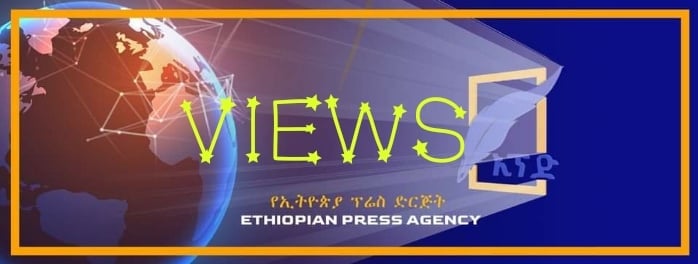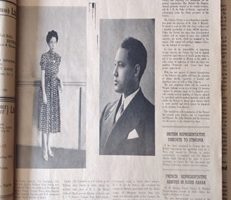
PART I
(Historian Nobelist, Career Surrealist
It’s more sinister than you thought. Put the pieces together, and it’s hard to escape the implication that the TPLF always intended to have a bloodbath, possibly one right across the country and in Addis if they had been more successful in battle. The clues are there. And evidence is waiting to be examined. Unfortunately, the top newspapers and TV networks of North America and Europe refuse to look really look.
In early March, a certain correspondent defended the highly questionable allegations over Axum and told me in a Twitter direct message, “The notion that remote investigations don’t count is utterly bogus.” I know a few academics that would spit up their coffee at this. And his logic presumes that reportage must be either-or. Yes, of course, you might get some valuable answers from behind your desk. But you better believe going there always beats long-distance calls, fuzzy satellite pictures and guessing.
Jemal Countess is a real journalist. He went to where the story is. A freelance photographer and former regional correspondent for Getty Images, he traveled to Mai Kadra in early March and spoke to witnesses and survivors of the horrors there that took place late last year.
An important detail to keep in mind: When Mai Kadra first broke in the Western news, major outlets such as Reuters and the Washington Post reported that the incidents of people “stabbed, strangled, and bludgeoned to death” took place on November 9 — they were following the narrative established by Amnesty International in its first report and by the Ethiopian Human Rights Commission, which visited Mai Kadra, Gondar and other towns in the region to investigate between November 14 to 19 and released findings on November 24.
But the witnesses Jemal Countess spoke to and photographed date the violence and killing back to November 6 and running until November 10.
“Most victims were slashed or hacked,” Countess wrote in his caption copy accompanying his pictures. “Many victims who survived the initial attacks with bladed weapons were shot to death.”
And it’s possible that some isolated murders might have happened well before even that timeline.
One witness, Solomon Abera, 40, told him he thinks the massacre was well planned very far in advance — at least by two weeks. “The wealthy Tigrayans who owned farms didn’t pay their laborers their wages and withheld them because they knew the genocide was coming. There are indications that they knew everything that was planned and that was going to happen… “I also know that Tigrayan Special Forces were arriving in Mai Kadra during the days leading up to the massacre.”
Solomon says the initial murders — those of workers who lived in farms — were hidden from local people, with officials and the farm owners using tractors to dump their bodies in ditches or in nearby bush beyond Mai Kadra River and sometimes the fields at Shilela Mocha.
Gashaw Birhanu, 43, knew of the horrors that were coming. Though he’s ethnically Amhara, he was mistaken for Tigrayan by community leaders in Mai Kadra and invited to two closed-door meetings before the fateful attack on the Ethiopian Northern Defense base. According to Gashaw, the Tigrayans at the meeting discussed how they would survive the imminent war, take control of resources in the region — and exterminate the local Amhara.
In the end, Gashaw’s charade didn’t protect him, and he was assaulted by seven men with sticks, managing to escape but losing his front teeth in the attack.
The implications from all these accounts are obvious. Countess says that several survivors and witnesses shared different bits of information with each other and drew the conclusion themselves that the massacre was planned long before. You can also look back and consider the behavior of the Tigrayan farmers, often retired veterans rewarded for service with land when the TPLF held its tight grip on the country.
“They stopped paying people a week and some change before the killing started,” says Countess. “So basically, they told people to either stay in Mai Kadra or for the day laborers to stay on the farms.” As the days counted down to the massacre, the targets of TPLF wrath couldn’t go anywhere without a pass. “They prohibited any Amhara from leaving Mai Kadra.” Laborers were made to harvest the fields — and then to die.
The preliminary findings of EHRC match some of the statements by the witnesses who spoke to Countess, such as the restriction of movement for Amhara and officials checking their identity cards.
Yet neither Amnesty nor the Ethiopian Human Rights Commission in their first reports pegged the violence earlier than November 9, nor did they make what seems an obvious link to the TPLF attacks on outposts of the Northern Defense Command on November 4.
But how, we might ask, did the Tigrayan residents and farmers choose those dates to slaughter their Amhara laborers and neighbors? If they held two local meetings in which killing was discussed, it’s reasonable to infer that these residents knew in advance from TPLF officers when the major push would start. And why don’t the Western media ever ask Debretsion Gebremichael about this?
For that matter, why doesn’t anyone ask Kjetil Tronvoll — “an expert on the TPLF with contacts deep within the party” as Al Jazeera once billed him — if he knew from his sources exactly when the attack on the Northern Defence Command would happen?
And if he knew innocent residents of Mai Kadra would be stabbed and beaten to death? And possibly others?
For if any Westerner deserves one day to be dragged as a witness into a courtroom over possible war crimes — if not as a potential defendant who may well have known what was coming — it is Kjetil Tronvoll, who wrote up what amounted to a TPLF ad for secession months before soldiers were attacked in their beds and who has been cheerleading for the rebels ever since.
“You’re going to find more bodies” When the Ethiopian Human Rights Commission visited in November, its team “noted that the pungent smell of decaying bodies still lingered in the air.”
By early March, if you couldn’t still smell them, you could find them. About thirty witnesses and survivors accompanied Jemal Countess as he went to view mass graves, pointing out the roughly eight different plots, where 50 people might be buried in one while 60 were likely buried in another.
People also took him to the edge of town where they showed him how bodies were buried in a ditch. In some cases, they were unable to remove the corpses for proper burial because they “were in too bad a shape to move,” not only because they were perhaps mutilated, but possibly due to the hot weather speeding up the rate of decomposition.
Initial reports suggested as many as 600 to 700 people were murdered. The death toll has been regularly revised upward, and Countess has put it at 1,300, expecting it to climb higher.
“If the region remains calm,” says Countess, “and you start to get to some of that private property where you had those TPLF retirees who committed those crimes on their farms, you’re going to find more bodies.”
And it will be hard to dispute who’s responsible, given who owned the land where they’re buried. Will we hear denials that oh, the bodies were buried without a farmer’s knowledge, and that he simply didn’t notice the fresh displacement of earth?
More than ever, Ethiopia doesn’t need human rights groups who do long-distance phone calls or interviews at refugee camps with unverified sources — it needs experienced forensics experts who can measure rate of body decomposition, who know how to study buildings strafed by machine gunfire, and who can interview genuine, traumatized witnesses and more questionable ones with a professional’s equal measure of compassion and detachment.
BY JEFF PEARCE
The Ethiopian Herald April 28/2021




